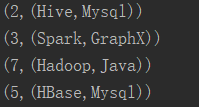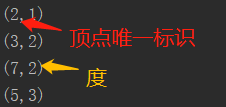Spark GraphX图计算简单案例【代码实现,源码分析】
一.简介
参考:https://www.cnblogs.com/yszd/p/10186556.html
二.代码实现
package big.data.analyse.graphx
import org.apache.log4j.{Level, Logger}
import org.apache.spark.graphx._
import org.apache.spark.rdd.RDD
import org.apache.spark.sql.SparkSession
class VertexProperty()
case class UserProperty(val name: String) extends VertexProperty
case class ProductProperty(val name: String, val price: Double) extends VertexProperty
/*class Graph[VD, ED]{
val vertices: VertexRDD[VD]
val edges: EdgeRDD[ED]
}*/
/**
* Created by zhen on 2019/10/4.
*/
object GraphXTest {
/**
* 设置日志级别
*/
Logger.getLogger("org").setLevel(Level.WARN)
def main(args: Array[String]) {
val spark = SparkSession.builder().appName("GraphXTest").master("local[2]").getOrCreate()
val sc = spark.sparkContext
/**
* 创建vertices的RDD
*/
val users : RDD[(VertexId, (String, String))] = sc.parallelize(
Array((3L, ("Spark", "GraphX")), (7L, ("Hadoop", "Java")),
(5L, ("HBase", "Mysql")), (2L, ("Hive", "Mysql"))))
/**
* 创建edges的RDD
*/
val relationships: RDD[Edge[String]] = sc.parallelize(
Array(Edge(3L, 7L, "Fast"), Edge(5L, 3L, "Relation"),
Edge(2L, 5L, "colleague"), Edge(5L, 7L, "colleague")))
/**
* 定义默认用户
*/
val defualtUser = ("Machical", "Missing")
/**
* 构建初始化图
*/
val graph = Graph(users, relationships, defualtUser)
/**
* 使用三元组视图呈现顶点之间关系
*/
val facts : RDD[String] = graph.triplets.map(triplet =>
triplet.srcAttr._1 + " is the " + triplet.attr + " with " + triplet.dstAttr._1)
facts.collect().foreach(println)
graph.vertices.foreach(println) //顶点
graph.edges.foreach(println) //边
graph.ops.degrees.foreach(println) // 各顶点的度
graph.triplets.foreach(println) // 顶点,边,关系
println(graph.ops.numEdges) // 边的数量
println(graph.ops.numVertices) // 顶点的数量
}
}
三.结果
1.三元组视图

2.顶点

3.边

4.各顶点的度

5.三元组视图

6.边/顶点数量

四.源码分析
class Graph[VD, ED] {
// Information about the Graph
val numEdges: Long
val numVertices:Long
val inDegrees: VertexRDD[Int]
val outDegrees: VertexRDD[Int]
val degrees: VertexRDD[Int]
// Views of the graph as collections
val vertices: VertexRDD[VD]
val edges: EdgeRDD[ED]
val triplets: RDD[EdgeTriplet[VD,ED]]
//Functions for caching graphs
def persist(newLevel1:StorageLevel = StorageLevel.MEMORY_ONLY): Graph[VD, ED]//默认存储级别为MEMORY_ONLY
def cache(): Graph[VD, ED]
def unpersistVertices(blocking: Boolean = true): Graph[VD, ED]
// Change the partitioning heuristic
def partitionBy(partitionStrategy: PartitionStrategy)
// Transform vertex and edge attributes
def mapVertices[VD2](map: (VertexId, VD) => VD2): Graph[VD2, ED]
def mapEdges[ED2](map: Edge[ED] => ED2): Graph[VD, ED2]
def mapEdges[ED2](map: (PartitionID, Iterator[Edge[ED]]) => Iterator[ED2]): Graph[VD, ED2]
def mapTriplets[ED2](map: EdgeTriplet[VD, ED] => ED2): Graph[VD, ED2]
def mapTriplets[ED2](map: (PartitionID, Iterator[EdgeTriplet[VD, ED]]) => Iterator[ED2]): Graph[VD, ED2]
// Modify the graph structure
def reverse: Graph[VD, ED]
def subgraph(epred: EdgeTriplet[VD,ED] => Boolean,vpred: (VertexId, VD) => Boolean): Graph[VD, ED]
def mask[VD2, ED2](other: Graph[VD2, ED2]): Graph[VD, ED] // 返回当前图和其它图的公共子图
def groupEdges(merge: (ED, ED) => ED): Graph[VD,ED]
// Join RDDs with the graph
def joinVertices[U](table: RDD[(VertexId, U)])(mapFunc: (VertexId, VD, U) => VD): Graph[VD, ED]
def outerJoinVertices[U, VD2](other: RDD[(VertexId, U)])(mapFunc: (VertexId, VD, Option[U]))
// Aggregate information about adjacent triplets
def collectNeighborIds(edgeDirection: EdgeDirection): VertexRDD[Array[VertexId]]
def collectNeighbors(edgeDirection: EdgeDirection): VertexRDD[Array[(VertexId, VD)]]
def aggregateMessages[Msg: ClassTag](sendMsg: EdgeContext[VD, ED, Msg] => Unit, merageMsg: (Msg, Msg) => Msg, tripletFields: TripletFields: TripletFields = TripletFields.All): VertexRDD[A]
//Iterative graph-parallel computation
def pregel[A](initialMsg: A, maxIterations: Int, activeDirection: EdgeDiection)(vprog: (VertexId, VD, A) => VD, sendMsg: EdgeTriplet[VD, ED] => Iterator[(VertexId, A)], mergeMsg: (A, A) => A): Graph[VD, ED]
// Basic graph algorithms
def pageRank(tol: Double, resetProb: Double = 0.15): Graph[Double, Double]
def connectedComponents(): Graph[VertexId, ED]
def triangleCount(): Graph[Int, ED]
def stronglyConnectedComponents(numIter: Int): Graph[VertexId, ED]
}
Spark GraphX图计算简单案例【代码实现,源码分析】的更多相关文章
- Spark GraphX图计算核心源码分析【图构建器、顶点、边】
一.图构建器 GraphX提供了几种从RDD或磁盘上的顶点和边的集合构建图形的方法.默认情况下,没有图构建器会重新划分图的边:相反,边保留在默认分区中.Graph.groupEdges要求对图进行重新 ...
- Spark技术内幕:Stage划分及提交源码分析
http://blog.csdn.net/anzhsoft/article/details/39859463 当触发一个RDD的action后,以count为例,调用关系如下: org.apache. ...
- 5.Spark Streaming流计算框架的运行流程源码分析2
1 spark streaming 程序代码实例 代码如下: object OnlineTheTop3ItemForEachCategory2DB { def main(args: Array[Str ...
- 仿爱奇艺视频,腾讯视频,搜狐视频首页推荐位轮播图(二)之SuperIndicator源码分析
转载请把头部出处链接和尾部二维码一起转载,本文出自逆流的鱼:http://blog.csdn.net/hejjunlin/article/details/52510431 背景:仿爱奇艺视频,腾讯视频 ...
- Spark大师之路:广播变量(Broadcast)源码分析
概述 最近工作上忙死了……广播变量这一块其实早就看过了,一直没有贴出来. 本文基于Spark 1.0源码分析,主要探讨广播变量的初始化.创建.读取以及清除. 类关系 BroadcastManager类 ...
- 史上最简单的的HashTable源码分析
HashTable源码分析 1.前言 Hashtable 一个元老级的集合类,早在 JDK 1.0 就诞生了 1.1.摘要 在集合系列的第一章,咱们了解到,Map 的实现类有 HashMap.Link ...
- 65、Spark Streaming:数据接收原理剖析与源码分析
一.数据接收原理 二.源码分析 入口包org.apache.spark.streaming.receiver下ReceiverSupervisorImpl类的onStart()方法 ### overr ...
- struts2 paramsPrepareParamsStack拦截器简化代码(源码分析)
目录 一.在讲 paramsPrepareParamsStack 之前,先看一个增删改查的例子. 1. Dao.java准备数据和提供增删改查 2. Employee.java 为model 3. E ...
- Spark GraphX图计算核心算子实战【AggreagteMessage】
一.简介 参考博客:https://www.cnblogs.com/yszd/p/10186556.html 二.代码实现 package graphx import org.apache.log4j ...
随机推荐
- shell的变量以及常见符号
shell的变量以及常见符号 常见变量 不同于其它语言需要先声明变量,shell的变量直接使用 eg: a=15 调用变量的话 $a 或者 ${a} $? #判断上一条命令执行的是否成功 0 ...
- java 类的继承
package testpacknm; import java.util.Scanner; import testpacknm.testcnm; class Another { String name ...
- ASP.NET开发实战——(四)ASP.NET MVC是如何运行的?它的生命周期是什么?
前面的文章我们使用ASP.NET MVC创建了个博客应用,那么它是如何工作的呢?我们都知道ASP.NET的程序需要部署到IIS上才能够通过浏览器来访问,那么IIS与ASP.NET MVC程序之间又是如 ...
- 【2019.7.15 NOIP模拟赛 T1】夹缝(mirror)(思维题)
思维题 此题应该是比较偏思维的. 假设一次反射后前进的距离是\(2^x(2y+1)\),则显然,它可以看做是前进距离为\(2^x\)的光线经过了\((2y+1)\)次反射,两者是等价的,甚至后者可能还 ...
- MySQL实战45讲学习笔记:第十六讲
一.今日内容概要 在你开发应用的时候,一定会经常碰到需要根据指定的字段排序来显示结果的需求.还是以我们前面举例用过的市民表为例,假设你要查询城市是“杭州”的所有人名字,并且按照姓名排序返回前 1000 ...
- Vue插槽详解 | 什么是插槽?
作者 | Jeskson 来源 | 达达前端小酒馆 什么是插槽?插槽的指令为v-slot,它目前取代了slot和slot-scope,插槽内容,vue实例一套内容分发的api,将slot元素作为承载分 ...
- 第04组 Alpha冲刺(1/6)
队名:new game 组长博客:戳 作业博客:戳 组员情况 鲍子涵(队长) 过去一段时间对项目的精度和分工进行了更加细致的划分,并初步进行了GamePlay逻辑部分的框架设计 GitHub签入记录: ...
- idea插件篇之java内存分析工具(JProfiler)
前言在运行java的时候有时候想测试云运行时占用内存情况,这时候就需要使用测试工具查看了.在eclipse里面有 Eclipse Memory Analyzer tool(MAT)插件可以测试,而在i ...
- oracle--sqlplus格式化输出
01,日期格式化输出 SQL> alter session set NLS_DATE_FORMAT='YYYY-MM-DD HH24:mi:ss'; SQL> select sysdate ...
- Java并发之原子操作类汇总
当程序更新一个变量时,如果是多线程同时更新这个变量,可能得到的结果与期望值不同.比如:有一个变量i,A线程执行i+1,B线程也执行i+1,经过两个线程的操作后,变量i的值可能不是期望的3,而是2.这是 ...
